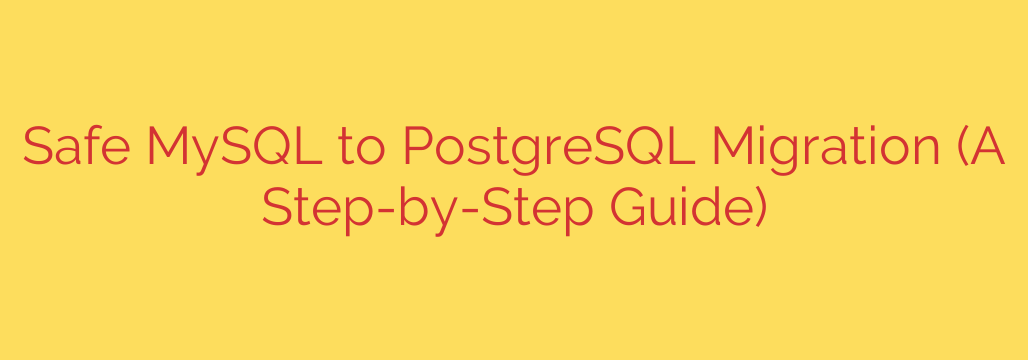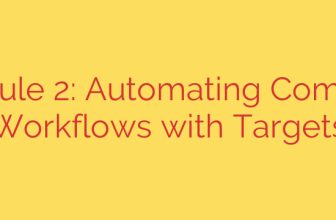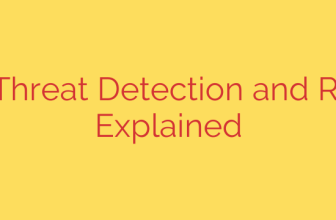
The Ultimate Guide to Migrating from MySQL to PostgreSQL Safely
Migrating from one database system to another is a significant undertaking. If you’re considering moving from MySQL to PostgreSQL, you’re likely drawn to its advanced features, robust extensibility, and strict SQL standards compliance. While the benefits are clear, the migration process itself can be complex and fraught with risks if not planned meticulously.
A successful migration ensures data integrity, minimizes downtime, and sets your application up for success on its new platform. This comprehensive guide provides a step-by-step framework for a secure and seamless transition from MySQL to PostgreSQL.
Before You Begin: The Pre-Migration Checklist
Proper planning is the most critical phase of any database migration. Rushing this stage can lead to data loss, extended downtime, and performance issues down the line. Before you move a single byte of data, complete this essential checklist.
- Analyze Your Database Schema: Thoroughly review your MySQL schema. Identify potential incompatibilities with PostgreSQL. Pay close attention to features like MySQL’s non-standard data type extensions or storage engines that don’t have a direct equivalent.
- Map Data Types: MySQL and PostgreSQL handle data types differently. You must create a clear mapping strategy. For example, MySQL’s
TINYINT(1)is often used for booleans, which should be mapped to PostgreSQL’s nativeBOOLEANtype. Similarly,DATETIMEin MySQL generally corresponds toTIMESTAMPin PostgreSQL. Documenting these conversions is crucial. - Address Stored Procedures and Triggers: The syntax for stored procedures, functions, and triggers is vastly different. MySQL uses its own procedural language, while PostgreSQL uses PL/pgSQL (and others). These components will need to be manually rewritten. This is often the most time-consuming part of the migration.
- Plan for
AUTO_INCREMENTConversion: MySQL uses theAUTO_INCREMENTproperty for primary keys. The PostgreSQL equivalent is theSERIALorIDENTITYcolumn type, which uses database sequences. Your migration script or tool must correctly handle the conversion and set the sequence to the right value to avoid primary key conflicts. - Create a Full, Verified Backup: This is a non-negotiable step. Before starting any migration process, perform a complete and verified backup of your entire MySQL database. Test the backup to ensure you can restore it successfully if anything goes wrong.
The Step-by-Step Migration Process
Once your planning is complete, you can begin the technical migration. Following these steps in order will help ensure a structured and successful outcome.
Step 1: Schema Migration
The first active step is to replicate your database structure in the new PostgreSQL environment. You cannot simply dump the MySQL schema and load it into PostgreSQL due to syntax differences.
- Export the Schema Definition (DDL): Use a tool like
mysqldumpwith the--no-dataflag to export only the table structures, indexes, and constraints. - Convert the Syntax: Manually edit the exported SQL file or use a conversion tool to translate the MySQL syntax to PostgreSQL-compatible syntax. Pay close attention to data types, character sets, and index definitions.
- Create the Schema in PostgreSQL: Execute the converted DDL script against your new PostgreSQL database to create the empty tables and structures.
Step 2: Data Migration
With the empty tables ready in PostgreSQL, it’s time to move the actual data. The method you choose will depend on your database size and downtime tolerance.
- For Small to Medium Databases: A common approach is the dump and restore method. Use
mysqldumpto export data into a neutral format like CSV. Then, use PostgreSQL’s powerfulCOPYcommand to efficiently import the data from the CSV files. This is fast and reliable but requires application downtime. - For Large Databases with Minimal Downtime: For critical systems, a continuous replication approach is better. Tools like pgloader can connect directly to a live MySQL database and migrate the data in a single command, handling schema and data conversion automatically. Other enterprise-grade tools like AWS Database Migration Service (DMS) can perform an initial full load followed by ongoing change data capture (CDC) to keep the PostgreSQL database in sync until you are ready for the final cutover.
Step 3: Post-Migration Validation and Testing
Never assume the migration was perfect. Rigorous validation is essential to guarantee data integrity and application functionality.
- Data Integrity Checks: Run queries on both databases to compare row counts for each table. For critical tables, perform checksums or compare a sample of rows to ensure data was transferred without corruption.
- Application Testing: Connect a staging version of your application to the new PostgreSQL database. Run your entire suite of integration and end-to-end tests to uncover any issues related to SQL query syntax differences or database behavior.
- Performance Testing: Your queries may perform differently on PostgreSQL. Use tools like
EXPLAIN ANALYZEto review query plans for slow-running operations and add necessary indexes or rewrite queries for optimal performance.
Step 4: The Final Cutover
After thorough testing and validation, you are ready for the final switch.
- Schedule a Maintenance Window: Inform your users of the planned downtime.
- Stop Your Application: Prevent any new writes to the old MySQL database.
- Perform a Final Data Sync: If using a replication method, perform one last sync to ensure the PostgreSQL database has the latest data.
- Update Application Configuration: Point your application’s database connection strings to the new PostgreSQL database.
- Restart Your Application: Bring your application online.
- Monitor Closely: Keep a close eye on application logs, database performance metrics, and error rates to quickly identify and resolve any post-cutover issues.
Post-Migration Best Practices
Once your application is running on PostgreSQL, your work isn’t done. Follow these best practices to ensure long-term stability and security.
- Analyze Tables: Run the
ANALYZEcommand on your new database. This collects statistics about the data distribution in your tables, which is critical for the PostgreSQL query planner to make intelligent decisions and ensure optimal query performance. - Review Security and Privileges: PostgreSQL has a more granular and powerful role-based security model. Review and tighten all user privileges, ensuring the principle of least privilege is followed. Do not reuse the same permissive user roles you may have had in MySQL.
- Establish a New Backup Routine: Decommission your old MySQL backup jobs and configure a robust backup and recovery strategy for your PostgreSQL database using tools like
pg_dumpor continuous archiving with Point-in-Time Recovery (PITR).
Migrating from MySQL to PostgreSQL is a strategic move that can unlock powerful new capabilities for your applications. By investing in careful planning, following a structured process, and performing rigorous validation, you can ensure a safe, secure, and successful transition.
Source: https://infotechys.com/migrate-mysql-to-postgresql/








